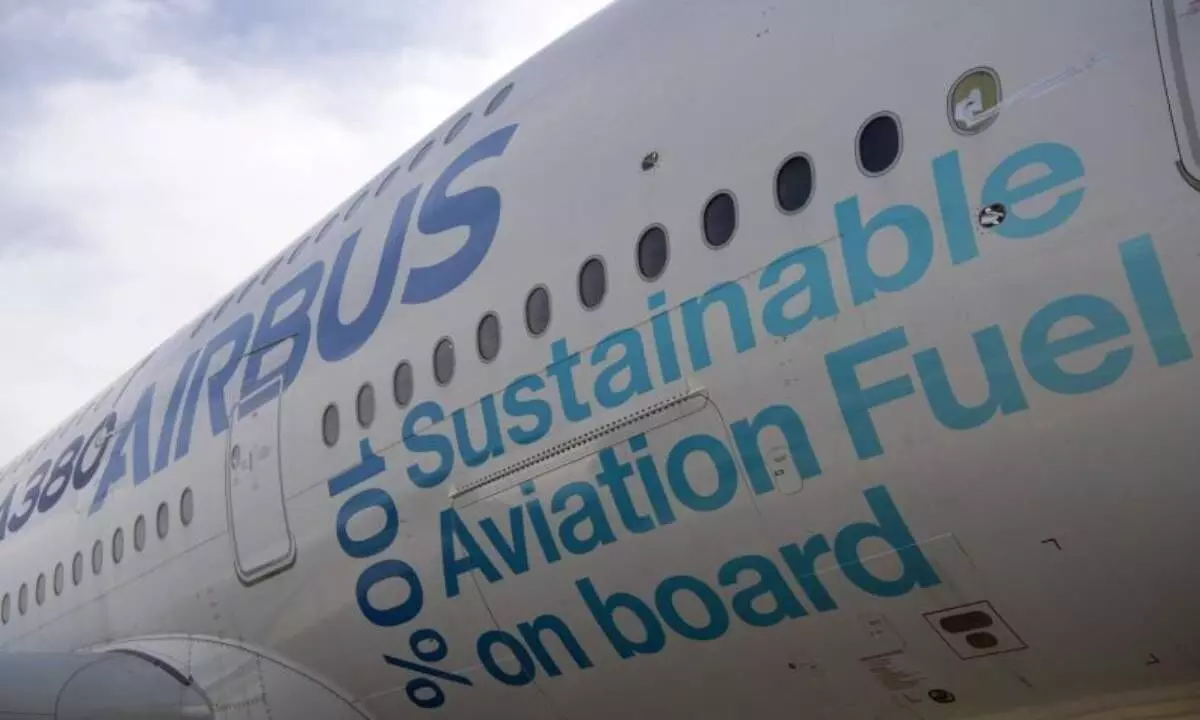A toss-up between SAF and hydrogen as the future aviation fuel
SAF, now costing up to eight times more than convention fuel, is impacting airlines financially
image for illustrative purpose

At the recent Paris Airshow the hottest topic revolved around which was the fuel of the future between SAF and hydrogen. Incidentally, both have backers. Boeing is betting big on SAF while Airbus is bullish on hydrogen.
Decarbonizing air transportation is a critical issue for the future of our industry. It notably rests on increasingly using Sustainable Aviation Fuel (SAF), along with leveraging other steps such as renewing our fleet with better fuel-saving and quieter aircraft, and rolling out eco-piloting-driven targeted operational measures.
By 2042, we estimate that more than 48,500 non-hydrogen commercial jets will be in service. Each will last decades – flying still in 2050. Emissions from those aircraft will need to be mitigated with SAF. Aviation must focus on developing and scaling SAF. However, it will take a ‘SAF and’ approach and not a ‘SAF or’ approach to achieving net-zero by 2050.
As part of the ‘SAF and’ approach, Boeing continues to advance the safety and viability of other renewable energy sources, such as hydrogen and electric, and their use on aircraft. However, under any scenario, the introduction of future advanced aircraft products with new energy carriers, will need exponential amounts of SAF if we are to meet the civil aviation’s commitment to net zero by 2050, says Lisa Maull, Global Enterprise Sustainability Communications director, Boeing.
Although we’ve known how to produce SAF for years (Air France and KLM started flying on SAF in 2009), today we are looking at limited levels of production and use – SAF made up 0.1% of the world’s consumption of aviation fuels in 2022. That same year, Air France-KLM bought 17% of global SAF production while the Group only accounted for 3% of the world’s kerosene consumption. It was a statement acquisition that spoke to the Group’s plans to lead the way in more sustainable aviation.
All eyes will be on sustainable aviation fuel to spearhead the decarbonization of air transportation. Production cannot yet keep up with the growing demand (airlines, plus land and sea transportation, etc.). It will take time to solve the inventory issue: an SAF production plant requires five to seven years before it can become fully operational.
Given the absence of an established production industry, SAF currently costs four to eight times more than convention fuel. This cost difference is already impacting airlines financially as well as fares. At current SAF prices in France, using 20% of SAF on a Paris-New York round trip in Economy class would add 175 euros to the airfare.
Strangely Airbus, a French company, is working on developing and putting into service the world’s first hydrogen-powered commercial passenger aircraft by 2035.
In close cooperation with its partners, Airbus will factor in aviation's requirement for hydrogen in New Zealand. As part of its ‘hydrogen hubs at airports’ concept, Airbus will engage with aviation and non-aviation players to perform a complete assessment of energy supply needs in order to enable operation of hydrogen powered aircraft.
The consortium we are building brings together a number of pioneering partners with a common interest: to make hydrogen-powered aviation in New Zealand a reality.
The partners are international aerospace leader Airbus, global green energy company Fortescue Future Industries (FFI), leading world airline Air New Zealand, next generation energy company Hiringa Energy, liquid hydrogen solution pioneers Fabrum and Christchurch airport.
The hydrogen market has a strong potential in terms of sustainable aviation and could account for 38% of all aircraft by 2050, according to McKinsey. Thanks to its ability to reduce CO2 emissions, diminish noise pollution and exploit renewable energy sources, hydrogen is increasingly seen as a promising alternative to fossil fuels. Many sector players, including Airbus and Alaska Airlines, have invested in research and development to design hydrogen solutions, which will reach the market over the coming years.
All three ZEROe concepts are hybrid-hydrogen aircraft. They are powered by hydrogen combustion through modified gas turbine engines. Liquid hydrogen is used as fuel for combustion with oxygen.
In addition, hydrogen fuel cells create electrical power that complements the gas turbine, resulting in a highly efficient hybrid-electric propulsion system. All of these technologies are complementary and the benefits additive.
Two hybrid-hydrogen turboprop engines, which drive eight-bladed propellers, provide thrust. The liquid hydrogen storage and distribution system is located behind the rear pressure bulkhead
Blended-Wing Body (BWB)
The exceptionally wide interior opens up multiple options for hydrogen storage and distribution. Here, the liquid hydrogen storage tanks are stored underneath the wings. Two hybrid-hydrogen turbofan engines provide thrust. Airbus has revealed that it is developing a hydrogen-powered fuel cell engine.
The propulsion system is being considered as one of the potential solutions to equip its zero-emission aircraft that will enter service by 2035.

